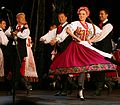Top Qs
Timeline
Chat
Perspective
National costumes of Poland
National costumes of Poland vary by region From Wikipedia, the free encyclopedia
Remove ads
National costumes of Poland (Polish: stroje ludowe) vary by region. They are typically not worn in daily life but at folk festivals, folk weddings, religious holidays, harvest festivals and other special occasions.[1] The costumes may reflect region and sometimes social or marital status.[1]
Poland's inhabitants live in the following historic regions of the country: Greater Poland, Lesser Poland, Mazovia, Pomerania, Warmia, Masuria, Podlachia, Kuyavia and Silesia.
Remove ads
Lesser Poland / Małopolska
Summarize
Perspective
- Kraków region:[2] The woman's costume includes a white blouse, a vest that is embroidered and beaded on front and back, a floral full skirt, an apron, a red coral bead necklace, and lace-up boots. Unmarried women and girls may wear a flower wreath with ribbons while married women wear a white kerchief on their head. The men wear a blue waistcoat with embroidery and tassels, striped trousers, a krakuska cap ornamented with ribbons and peacock feathers and metal rings attached to the belt.
- Lachy Sądeckie live in southern Lesser Poland, especially in Nowy Sącz County and Kotlina Sądecka.
- Western Kraków region
- Eastern Kraków region
- Kraków region
- Lachy Sądeckie men's costume
- Lachy Sądeckie, including married woman's costume
- Lachy Sądeckie, including unmarried woman's costume
- Lesser Poland
Gorals / Górale
Gorals live in southern Poland along the Carpathian Mountains, in Podhale of the Tatra Mountains and parts of the Beskids. Their costumes vary depending on the region.[3]
- Żywiec
- Podhale
- Zakopane (1938)
- Szczawnica (1939)
- Gorals from Cieszyn Silesia
- Tatra Gorals in 1877
- Żywiec Gorals in 2016
- Żywiec Gorals in traditional costume
- Podhale Gorals in traditional costume
Subcarpathian region / Podkarpacie
- Pogórzanie
- Pogórzanie
- Rzeszowiacy
- Pogórzanie
- Sanok (Kamraty)
- Lasowiacy (Mazurians)
- Rymanów (Pogórzanie)
- Liszna (Sanok)
- Lemkos from Przemyśl
Lublin region
- Lublin region
- Lublin
- Biłgoraj
Remove ads
Silesia / Śląsk
- Bytom / Piekary Śląskie in Upper Silesia[7]
- Cieszyn Silesia, see
- Lower Silesia
- Lower Silesia
- Wilamowice, Vilamovians
Pomerania / Pomorze, Kujawy, Warmia
- Kashubia
Masovia and central Poland
Places in Masovia with distinctive costumes include:
- Łowicz[12][13][14]
- Kurpie of the Green and White Primeval Forests[1][15][16]
- Wilanow
- Opoczno[17]
- Sieradz[18]
- Kurpie
- Central
- Green Forest Kurpie
- Green Forest Kurpie in 1913
Podlaskie / Podlasie
- Podlasie
Greater Poland / Wielkopolska
Upper class
The szlachta were Polish nobles and had their own attire which included the kontusz, pas kontuszowy (sash) and a crimson żupan.[20]
- Nobility
- Bractwo Kurkowe (Kraków)
- Bractwo Kurkowe (Kraków)
- 17th century
- Żywiec
- King Stanisław I in a Cracovian costume
Burghers
Mieszczanie were Polish burghers, among whom in 18th century czamaras gained a lot of popularity (especially in the Kraków region, hence the alternative name Kraków coat for czamara). In 19th century czamara became a Polish national and patriotic attire.[21]
- Men in czamaras
- Man wearing a czamara
See also
References
External links
Wikiwand - on
Seamless Wikipedia browsing. On steroids.
Remove ads





























































